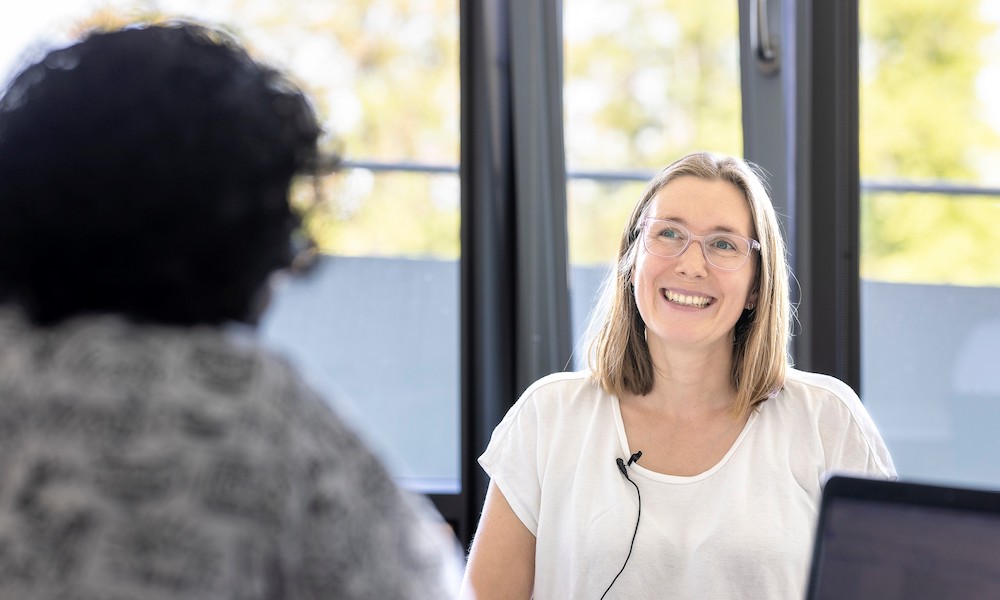What it is like to be a scientist at the frontier of knowledge

Dr Merle Hantsche-Grininger sheds light on what it’s like working at the forefront of cell biology research
By Hariharan Arevalagam
Leading up to our latest virtual LearningLAB featuring Dr Jan Ellenberg as a keynote speaker, Hariharan Arevalagam sat down with Dr Merle Hantsche-Grininger, a postdoc at the Ellenberg Group at EMBL Heidelberg, to talk about her research, what the life of a scientist is really like, advice for students, and much more.
Merle is a biochemist, and her focus in the Ellenberg Group is chromatin architecture; making chromatin visible by developing a method that allows the labelling of DNA and the proteins that define its compactisation. Before getting into the details of her research, she tells Hariharan about her experience as a high school student.
Can you tell me more about what your specific research is about? How does your research contribute to the bigger picture, and what is the bigger picture anyway?
I’ll start a bit broader here: DNA does not exist naked but exists in an intricate complex with proteins, forming the so-called chromatin. These proteins organise our DNA on many levels. But chromatin organisation is still a mystery.
To start with, in each cell, there are two metres of DNA. If we unwind our chromosomes and then line up the DNA double helices next to each other, it would be two metres long. The diameter of a cell nucleus, depending on the type of cell, is just a few micrometres and this long stretch of DNA fits into it. To give an analogy, it would be like trying to fit a fishing line that’s 200 km long into a soccer ball. Even more fascinating is that all the cells in our body are different; we have skin cells, liver cells, eye cells, and hair cells, but they all contain the same DNA. The spatial organisation of the DNA determines which genes are expressed in each cell, which in turn determines the cell’s fate, or what we call phenotype.
Think of it like this: the nucleus is considered the “library” of the cell. The books are the information carried in DNA. The shelves are the proteins. Depending on how the library is arranged, you might only have access to certain shelves and books, not others. Differently arranged libraries can be found in the different types of cells. Understanding chromatin organisation gives us an understanding of how a cell organises all the DNA information that is the same in all cells by how it arranges these metaphorical bookshelves.
So, what I am currently doing is to purely gain knowledge about something that we don’t understand. If we understand the principles of chromatin folding, this has, of course, implications for medical and pharmaceutical applications. Personalised medicine, for example, is highly dependent on understanding your DNA and what kind of potential diseases you might get.
The topic of chromatin organisation nicely illustrates that scientific advancement and insight always depend on the methods and techniques that we have available. A few years ago, we had X-ray crystallography that let us look at details on a very small scale of nuclear organisation, and we had light microscopy that let us look at things on a bigger scale. So, we could see chromosomes, but everything between chromosomes and nucleosomes was invisible. There was no microscopy method that looked at the “in-between” scales of chromatin organisation. Now, with super-resolution microscopy, we have the techniques and the possibility to look at these finer scales inside the cell. And this is the very first time we can do this! This is what makes it interesting because no one has seen what chromatin looks like at this resolution. So, what we know always reflects the current state of technology.
How does it feel to be at the frontier of knowledge?
It’s great! It’s so exciting! Because after having finally figured out all the technical details, I now have a super-resolution image of this chromatin organisation, and I know I’m the first person in the world looking at this. It’s just really cool!
Where do you see the future of your field? Based on our conversation, I don’t think we’re ever going to be done with this scientific endeavour.
I think we are never done. That’s the beauty of it, right? With every open question that we answer, ten more arise. The genome is the essence of our body, and understanding nuclear organisation will help us understand what life is. I think we’re all driven by the essential questions, the big questions: What is life? What defines life? How do these millions of cells communicate, and how do we develop a personality from all these biochemical processes? These are fundamental questions, and I am working on unravelling a very fine detail relevant to one of these questions. But if we understand many small details, we can put them together, and that’s the fun part! You have many people, thousands of research groups worldwide, working on many small details. It is so rewarding when you can put the small details into a bigger picture and start to understand how everything comes together.
The research carried out by the Ellenberg Group forms the core research topic of our upcoming virtual LearningLAB, “The cellular basis of life”. For more information on how you can participate, head on over to the course page here.
Click here to read Merle’s full interview and learn more about her school years, how to motivate students to become scientists, and what it takes to become one.
All scientific terms mentioned in the interview are explained in a glossary. Therefore, you can use Merle’s story to excite your students about research and cell biology.
Enjoy the read!
